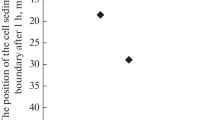Summary
An inverse relationship between 2,3-bisphosphoglycerate levels and the ratio calculated from pyruvate kinase and bisphosphoglycerate mutase activities has been observed in red populations of rats during animal development. Counter-current distribution in aqueous two-phase systems of these cells populations shows a displacement of distribution profiles towards the high-numbered cavities of the rotor as animal ages. Heterogeneity of cells after distribution is only observed during the switching process from fetal to adult red cells taking place along the postnatal stage of development. Values for the pyruvate kinase/bisphosphoglycerate mutase ratio in these fractions suggest the separation of fetal (liver) from adult (bone marrow) red cells.
Similar content being viewed by others
References
Bunn HF, Seal US, Scott AF: The role of 2,3-disphosphoglycerate in mediating hemoglobin function of mammalian red cells. Ann NY Acad Sci 241: 498–512, 1974
Benesch R, Benesch R: The mechanism of interaction of red cell organic phosphates with hemoglobin. Adv Protein Chem 28: 211–237, 1974
Bartlett GR: Phosphate compounds in vertebrate red blood cells. Am Zool 20: 103–114, 1980
Jelkmann W, Bauer C: The regulation of red cell oxygen affinity and 2,3-P2-glycerate level during rabbit ontogeny. In: SR Hollán, G Gàrdos and B Sarkadi (eds) Genetics, Structure and Function of Blood Cells. Akadèmiai Kladò, Budapest, 1981, pp 115–123
Jelkmann W, Bauer C: Enzyme activities related to 2,3-P2glycerate matabolism in embryonic and fetal red cells. Biochem Biophys Res Comm 93: 93–99, 1980
Gilman JG: Rat embryonic and foetal erythrocytes. Biochem 1192: 335–359, 1980
Jelkmann W, Bauer C: High pyruvate kinase activity causes low concentrations of 2,3-disphosphoglycerate in fetal rabbit red cells. Pflügers Arch 375: 189–195, 1978
Jelkmann W, Bauer C: 2,3-BPG levels in relation to red cell enzyme activities in rat fetuses and hypoxic newborns. Pflügers Arch 389: 61–68, 1980
Jacobasch G, Minakami S, Rapoport SM: Glycolysis of the erythrocyte. In: H Yoshikawa and SM Rapoport (eds) Cellular and Molucular Biology of Erythrocytes. Urban and Schwarzenberg, Munich, 1974, pp 55–92
Rose IA, Warms JV: Control of red cell glycolysis. J Biol Chem 245: 4009–4015, 1970
Albertsson PA: Partition of cell particles and macromolecules, 3rd ed. Wiley, New York, 1986
Walter H, Brooks BE, Fisher D (eds): Partitioning in aqueous two-phase systems. Academic Press, Orlando, 1985
Luque J, Delgado MD, Ferrer E, Moreno M, Pinilla M, Sancho P: The use of two-phase systems for the fractionation of heterogeneous populations of bone marrow cells and erythrocytes. Bisphosphoglycerate mutase as enzyme marker for erythroid cells. In: IN Rich (ed) Molecular and Cellular Aspects of Erythropoietin and Erythropoiesis. NATO ASI Series vol. H8. Springer-Verlag, Berlin, 1987, pp 353–371
Luque J, Delgado MD, Rodriguez-Horche P, Company MT, Pinilla M: Bisphosphoglycerate mutase and pyruvate kinase activities during maturation of reticulocytes and ageing of erythrocytes. Bioscience Reports 7: 113–119, 1987
Pinilla M, Rodriguez-Horche P, Luque J: Pyruvate kinase activity and response to allosteric effectors in rat erythrocytes and reticulocytes fractionated by multiple partitioning in aqueous two phase systems. Cell Biochem and Function 5: 301–307, 1987
Sancho P, Delgado MD, Garcia-Perez AI, Luque J: Fractionation of bone marrow cells by counter-current distribution in aqueous polymer two-phase systems. Relation between settling time and the efficiency of separation. J. Chromatogr 380: 339–345, 1986
Zijlstra WG, Van Kampen EJ: Spectrophotometric measurement of haemoglobin: the standard haemoglobin cyanide method and after. J Clin Chem Clin Biochem 19: 521–523, 1981
Valentine WN, Tanaka KB: Pyruvate kinase, Clinical Aspects. In: WA Woods (ed) Methods in Enzymology vol 9, Academic Press, New York, pp 468–473, 1966
Pineda M, Luque J: Spectrophotometric assay of bisphosphoglycerate mutase: A reexamination of Rapoport-Luebering's method. Biomed Biochem Acta 43: 919–927, 1984
Delgado MD, Luque J: Bisphosphoglycerate mutase in erythrocytes: comparison of two spectrophotometric assay methods. In: Adv Clin Enzymol vol 4. Karger, Basel, 1986, pp 160–168
Sanderson JH, Philips CE: An Atlas of Laboratory Animal Haematology. Clarendon Press, Oxford, 1981
Bender E: Red Cell Metabolism. A Manual of Biochemical Methods. Grune and Stratton, Orlando, 1984.
Author information
Authors and Affiliations
Rights and permissions
About this article
Cite this article
Pinilla, M., Jimeno, P., Moreno, M. et al. Fractionation in two-phase systems of red cells during rat development: Changes in pyruvate kinase and bisphosphoglycerate mutase activities in relation to red cell switching. Mol Cell Biochem 94, 37–44 (1990). https://doi.org/10.1007/BF00223560
Received:
Accepted:
Issue Date:
DOI: https://doi.org/10.1007/BF00223560




